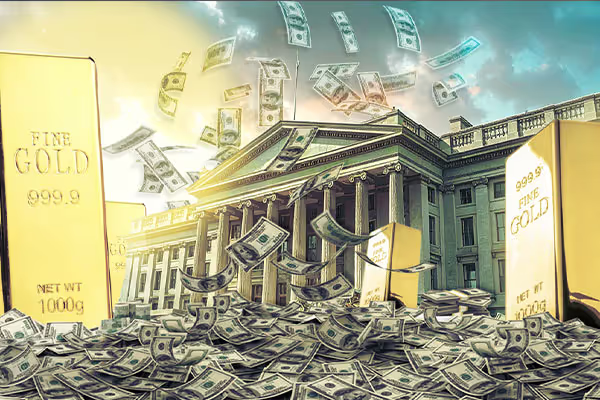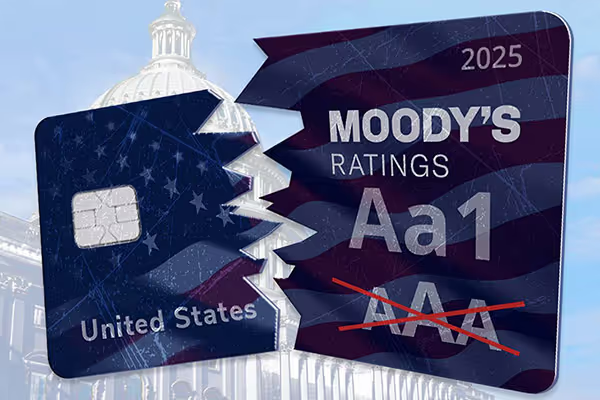The AI Bubble and Your Wealth
Lessons From the Dot-Com Crash Reveal Why Gold Remains the Safest Hedge in an Era of Hype
The comparison between today’s artificial intelligence frenzy and the dot-com bubble of the late 1990s has become impossible to ignore. As AI companies command valuations in the hundreds of billions — minting dozens of new billionaires in 2025 alone — and tech giants pour unprecedented sums into data centers, investors are asking: Are we watching history repeat itself?
For many, the answer is unsettling. History shows that bubbles can enrich a few but devastate the unprepared. That’s why smart investors are hedging with gold. Unlike AI stocks or tech-heavy funds, gold’s value doesn’t depend on quarterly earnings, hype cycles, or government policy shifts. It’s a constant when everything else is in flux.
Like the internet firms of two decades ago, AI companies attract massive investment based on potential rather than current profitability. Global corporate AI investment hit $252.3 billion in 2024, a thirteenfold increase since 2014, according to Stanford University. Amazon, Google, Meta, and Microsoft alone are spending a record $320 billion on capital expenditures this year, much of it on AI infrastructure.
Even OpenAI CEO Sam Altman, whose company is valued at roughly $500 billion, acknowledges the hype. “Are we in a phase where investors as a whole are overexcited about AI? My opinion is yes,” Altman said in August.
Lessons From the Dot-Com Crash
The dot-com bubble burst not from one event, but a convergence of forces. The Federal Reserve raised rates from 4.7% to 6.5% between 1999 and 2000, making speculative bets less attractive. At the same time, Japan slipped into recession, sparking global market jitters. Investors then reassessed sky-high valuations of firms that had little more than website traffic to show.
Examples abounded: Commerce One reached a $21 billion valuation with negligible revenue; TheGlobe.com stock soared 606% on day one despite no viable model; Pets.com burned through $300 million in under a year before collapsing.
Another lesson was infrastructure overbuild. Telecoms, misled by WorldCom’s false claim that internet traffic doubled every 100 days, laid more than 80 million miles of fiber optic cable. Even four years later, up to 95% was unused—“dark fiber” that sank companies like Corning and Ciena.
Déjà Vu in the Data Center
Today, AI is following a similar path. Meta CEO Mark Zuckerberg announced a data center “so large it could cover a significant part of Manhattan.” The $500 billion Stargate Project, backed by OpenAI, SoftBank, Oracle, and MGX, aims to create a nationwide AI network.
Unlike the dot-coms, leading AI players are making money. Microsoft’s Azure cloud business, heavily AI-driven, grew 39% year-over-year to an $86 billion run rate. OpenAI projects $20 billion in annualized revenue by year’s end, up from $6 billion at the start of 2025.
But the revenue gap remains glaring. As tech writer Ed Zitron notes, Microsoft, Meta, Tesla, Amazon, and Google invested $560 billion in AI infrastructure over the last two years, but generated just $35 billion in AI-related revenue. An MIT study found 95% of AI pilot projects fail to yield meaningful results.
This mismatch—massive spending, modest returns—is exactly when gold proves its worth. When investors chase speculative gains, safe havens like gold offer stability. That’s why central banks continue to add to their reserves, and why more Americans are protecting retirement savings with physical gold.
Warning Signs From the Fed
Even the Federal Reserve is sounding cautious. Chair Jerome Powell recently acknowledged “unusually large amounts of economic activity through the AI buildout.” He pointed to how this surge skews heavily toward the wealthy, while ordinary households struggle.
Seven firms — Microsoft, Nvidia, Apple, Alphabet, Meta, Amazon, and Tesla — now make up more than 30% of the S&P 500’s value. Meanwhile, 70% of U.S. GDP relies on consumer spending, yet most households live paycheck to paycheck. Powell noted that “kids coming out of college and younger people, minorities” are struggling to find jobs in today’s cooling labor market, even as tech giants pour billions into AI.
This “K-shaped” economy — where the wealthy thrive while most families cut back — resembles the late ’90s, when capital flowed into speculative bets while the broader economy weakened.
Why Gold Matters More Than Ever
History shows that even transformative technologies cannot escape economic gravity. The internet ultimately did change the world—but not before wiping out investors who chased hype without a hedge.
Gold offers that hedge. Unlike equities tied to quarterly results or political promises, gold is tangible, apolitical, and globally trusted. As AI valuations climb and wealth pools into a few firms, gold provides stability outside the system. For investors wary of déjà vu, owning gold is not just wise — it’s essential.
Reagan Gold Group — Your Partner in Protection
At Reagan Gold Group, we believe financial security comes from assets you control directly, not from speculative bubbles or government promises. That’s why we help Americans diversify retirement accounts into physical gold and silver—real assets with enduring value. Whether you’re considering a Precious Metals IRA rollover or direct ownership of gold and silver coins, our team is here to guide you every step of the way.
















